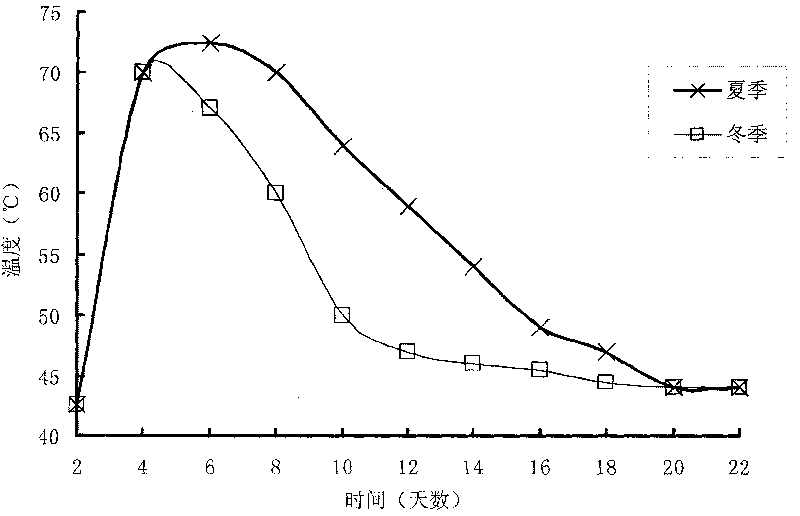Compound padding for fermentation bed cultivation and preparation method thereof
A composite mat and fermentation bed technology, applied in the field of composite litter, can solve the problems of non-fermentation, slow temperature rise, limited litter composition, etc.
- Summary
- Abstract
- Description
- Claims
- Application Information
AI Technical Summary
Problems solved by technology
Method used
Image
Examples
Embodiment 1
[0041] Sawdust, peanut shells, rice husk powder, molasses, rice bran, and compound microbial preparations are used as litter materials, and the uniform litter production mode is adopted. The stacking fermentation method is taken as an example.
[0042] 1. Production of padding
[0043] 600kg of sawdust; 200kg of peanut shells; 200kg of rice hulls; 1kg of molasses; 10kg of rice bran; 95%, passing through a 0.5cm sieve <20%. Then, while mixing sawdust, peanut hulls, rice hulls and the mixture of microbial preparations, molasses and rice bran, tap water is added to adjust the moisture content to 55%. Finally, it is stacked into ladders and covered with a burlap bag.
[0044] 2. Temperature monitoring during the fermentation process
[0045] Refer to the drawings in the manual to detect the temperature change of fermentation
[0046] 3. Judgment of indicators after fermentation
[0047] Sensory indicators: Hold a handful of fermented litter and spread it in your hands; the sm...
Embodiment 2
[0049] Sawdust, sawdust, cotton stalks, corn stalks, brown sugar, wheat bran, and compound microbial preparations are used as litter materials, and the layered litter production mode is adopted, taking the flat-laying fermentation method as an example.
[0050] 1. Production of padding
[0051] Sawdust 400kg; sawdust 200kg; cotton stalk 200kg; corn stalk 100kg; brown sugar 1kg; wheat bran 10kg; microbial preparation 1kg. Then process the sawdust and cotton stalks so that they pass through a 1.25cm sieve ≥ 95%, and pass through a 0.5cm sieve <20%. Before laying the litter, first spread the corn stalks (not crushed) on the bottom of the litter pool, then lay the sawdust, sawdust, and cotton stalks in sequence, sprinkle a certain amount of strains evenly on each layer, and add tap water at the same time , adjust the moisture to 60%. Finally, 20-30cm of sawdust is laid on the surface. Finally, the surface is covered with a burlap bag.
[0052] 2. Temperature monitoring during ...
Embodiment 3
[0057] The litter of the present invention is applied to a certain pig farm in Beijing to verify the application effect of the fermented litter. The test adopts a completely random design, and the pig feeding stage is from 25kg to the market. The experimental group was raised on a fermentation bed, and the control group was raised on a traditional hard cement floor. 120 growing and fattening pigs were selected (du long-term hybridization), randomly divided into 2 treatments, each treatment had 4 replicates, and each replicate (pen) had 15 pigs, males and females each accounted for 1 / 2. The experimental pigs were group-fed, with free access to food and water, added feed once a day at 08:00 and 16:00, and disinfected according to the routine procedures of the pig farm.
[0058] After the breeding, the benefits of litter breeding and traditional hard cement breeding are as follows:
[0059]
[0060]
[0061] The attached figure is the temperature curve of th...
PUM
 Login to View More
Login to View More Abstract
Description
Claims
Application Information
 Login to View More
Login to View More - R&D
- Intellectual Property
- Life Sciences
- Materials
- Tech Scout
- Unparalleled Data Quality
- Higher Quality Content
- 60% Fewer Hallucinations
Browse by: Latest US Patents, China's latest patents, Technical Efficacy Thesaurus, Application Domain, Technology Topic, Popular Technical Reports.
© 2025 PatSnap. All rights reserved.Legal|Privacy policy|Modern Slavery Act Transparency Statement|Sitemap|About US| Contact US: help@patsnap.com

